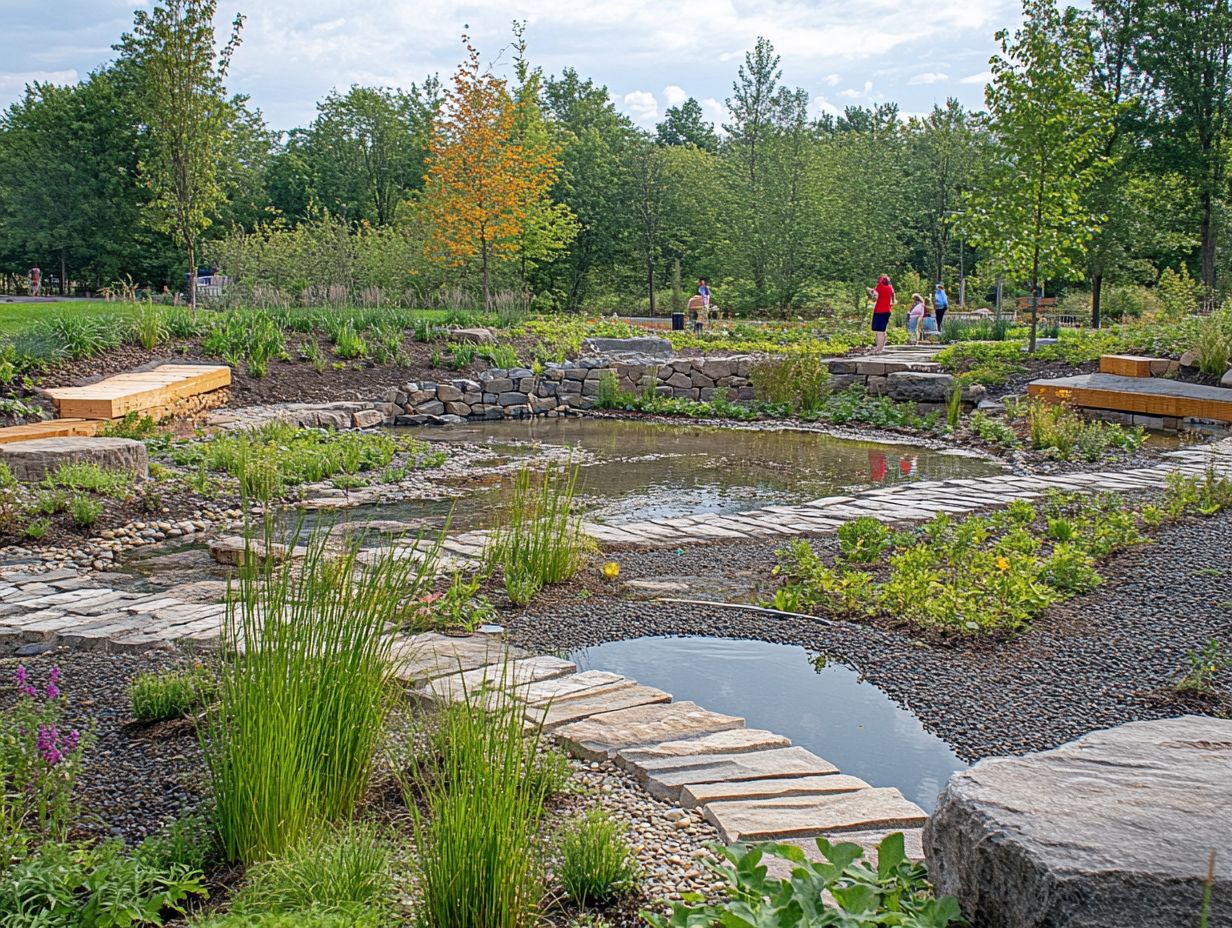Principles of Water Management in Design
With water scarcity on the rise, effective management is more critical than ever. Water management in design is essential for crafting sustainable and efficient spaces that honor our most precious resource.
This article delves into the profound influence design has on water resources. It highlights crucial principles such as efficiency, conservation, sustainability, and reuse.
Explore effective strategies for incorporating water management into your design projects. Gain insights from real-world case studies that exemplify successful implementation.
Engage with us to discover how intentional design can pave the way for a more sustainable future for our water systems.
Contents
Key Takeaways:

- Implement sustainable practices for efficient and effective water management.
- Consider key principles, including efficiency, conservation, and integration with design elements.
- Explore successful case studies that demonstrate effective water management techniques.
The Importance of Water Management in Design
Water management is a cornerstone of sustainable design. It greatly impacts how systems like wastewater treatment, groundwater storage, and stormwater runoff control function.
To preserve water resources and tackle challenges posed by climate change, implementing effective strategies is essential. Organizations like the EPA champion innovative methods, emphasizing the importance of community engagement and awareness in the stewardship of our watershed ecosystems.
By prioritizing proper water management, you can enhance water conservation, support ecosystem health, and create resilient environments that meet regulatory guidelines while embodying best practices.
Understanding the Impact of Design on Water Resources
Design decisions play a crucial role in enhancing water use efficiency. They influence everything from your choice of restroom fixtures to the implementation of cooling towers and single-pass cooling systems.
By selecting fixtures that minimize water flow without sacrificing performance, you can significantly decrease overall water consumption in your facilities. Optimizing your cooling systems conserves water and boosts operational efficiency, illustrating how an integrated design approach can yield impressive benefits.
It s essential to think beyond individual components. Managing stormwater runoff is key. Effective drainage and retention strategies can mitigate flooding while promoting groundwater recharge.
Embracing water-smart landscaping practices, such as xeriscaping and selecting native plants, is vital. This reduces irrigation needs while enhancing the visual appeal of your environment. Such thoughtful design demonstrates how functionality and environmental stewardship can beautifully coexist.
Key Principles of Water Management
The key principles of water management focus on efficiency, sustainability, and strategic reuse of resources. Adhering to these principles is crucial for effectively addressing the challenges of climate change.
Efficiency and Conservation

Achieving water use efficiency and promoting water conservation are essential components of sustainable design. You can leverage technologies like reverse osmosis and steam sterilizers to accomplish this.
Utilizing advanced irrigation systems, such as drip irrigation, minimizes water wastage while ensuring crops receive the perfect amount of moisture right at their roots. Consider implementing rainwater harvesting systems to capture and store precipitation, providing a supplementary water source for your landscapes and gardens.
Case studies from urban environments reveal that integrating water-efficient fixtures in commercial buildings like low-flow faucets and dual-flush toilets can dramatically reduce overall water usage without compromising user experience.
Together, these strategies and technologies empower you and your community to conserve this vital resource while maintaining a steadfast commitment to environmental sustainability.
Sustainability and Reuse
Sustainability in water management highlights the significance of water reuse. It encourages you to adopt strategies like rainwater recovery and modern methods of cleaning used water to ease the strain on existing water resources.
These methods don t just safeguard precious freshwater supplies; they also comply with the regulatory guidelines set forth by the Environmental Protection Agency (EPA). By aligning with these standards, you can implement practices that effectively minimize environmental impact while promoting responsible water management.
For example, utilizing treated greywater for irrigation or toilet flushing conserves potable water and bolsters local ecosystems. As communities increasingly prioritize water sustainability, grasping the implications of the EPA s regulations becomes essential for designing systems that champion efficient and environmentally friendly water use.
Integration with Design Elements
Integrating water management into your design elements think water-smart landscaping, cooling towers, and efficient restroom fixtures can dramatically reduce stormwater runoff. This strategy enhances sustainability and maximizes resource utilization.
For example, incorporating native plants into your landscaping can significantly lessen the need for irrigation. Cutting-edge cooling towers can capture and reuse water that would otherwise be wasted.
By installing low-flow restroom fixtures, you can minimize water consumption without compromising user experience. Prioritizing these features allows you to create spaces that fulfill aesthetic and functional requirements while fostering environmental stewardship and delivering long-term cost savings.
Implementing Water Management in Design Projects
Implementing effective water management strategies in your design projects necessitates a collaborative approach. Engage the community and align with EPA guidelines to tackle the challenges posed by climate change.
Strategies and Techniques

Adopting strategies such as rainwater recovery, advanced wastewater treatment, and water-smart landscaping can significantly enhance water management in your design projects.
These approaches optimize your use of water resources and contribute to sustainability and cost savings. For instance, by incorporating rain gardens or permeable pavements, your projects can effectively capture and filter stormwater, reducing runoff while enhancing local ecosystems.
Utilizing smart irrigation technologies ensures that your landscapes receive water only when necessary, preventing unnecessary waste. Advanced treatment methods, like membrane bioreactors which are advanced systems that treat wastewater efficiently and constructed wetlands allow you to recycle wastewater for non-potable uses.
These innovative strategies play a critical role in conserving this vital resource while promoting environmental health. Act now to embrace water sustainability!
Case Studies of Successful Water Management in Design
By examining case studies of successful water management in design, you can uncover the effectiveness of various strategies implemented across diverse regions such as Maryland, Minnesota, Iowa, Florida, and Texas.
This exploration showcases how these regions have adapted and emphasizes the crucial role of EPA water guidelines in addressing climate change challenges. Join the movement for smarter water management today!
Real-World Examples and Results
Real-world examples of successful water management demonstrate the remarkable outcomes that arise from using sustainable design methods, such as the effective application of reverse osmosis (a method to purify water) and innovative strategies for managing stormwater runoff (water from rain or melted snow that doesn’t soak into the ground).
Take a community in California, for instance. They adopted a reverse osmosis system that greatly improved the quality of drinking water, slashing contaminants by over 90%. This success was not just about the tech; it actively involved local residents through workshops and public meetings, allowing them to shape the project according to their specific needs.
In a similar vein, a stormwater management initiative in Portland incorporated permeable pavement and green roofs. This initiative not only cut flooding by 40% but also enhanced local biodiversity. The active participation of community members in both planning and maintenance ensured that these interventions would remain sustainable over the long haul. Effective water management is about engaging people as much as using technology.
Frequently Asked Questions
What are the principles of water management in design?

Key principles include using less water, ensuring clean water, managing stormwater, promoting conservation, and implementing sustainable practices. These practices are crucial, particularly in a changing climate and watershed ecosystems.
How can water use be minimized in design?
You can minimize water use by using water-saving restroom fixtures and appliances, incorporating native and drought-resistant plants in water-smart landscaping, and implementing water recycling systems like rainwater recovery.
Why is protecting water quality important in design?
Protecting water quality is essential to ensure the health and safety of both humans and the environment, in accordance with the Clean Water Act and Safe Drinking Water Act. This includes preventing contamination from pollutants and preserving natural water sources.
What steps can be taken to manage stormwater runoff in design?
To manage stormwater runoff in design, strategies such as incorporating green infrastructure, implementing rain gardens and bioswales, and using permeable pavement can be employed. These measures help prevent flooding and filter pollutants before they reach water sources, contributing to effective wastewater treatment.
How can water conservation be promoted in design?
Water conservation can be promoted in design by incorporating water-efficient technologies, implementing water reuse systems, and educating users on the importance of conserving water. Community involvement is key to sustainable design practices.
Why is considering the water cycle important in design decisions?
Considering the water cycle in design decisions allows for a holistic approach to water management. This takes into account the entire water system, its impact on the environment, and the role of groundwater storage, thus helping to create more sustainable and resilient designs.






